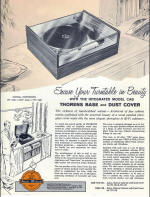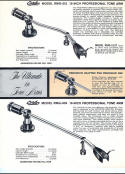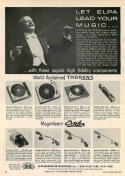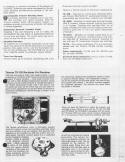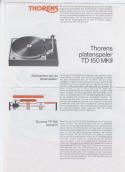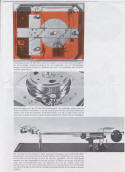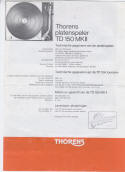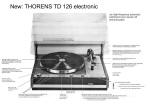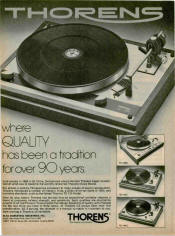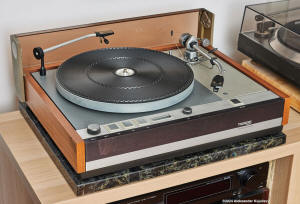-edible zone-
-- A brief summary of the company's history, developments and product line
1883 Trade registration of the
family-business of Hermann Thorens, established in St.-Croix /
Switzerland, with the purpose of manufacturing musical boxes and
movements.
1903 Manufacturing of Thorens' first Edison-type
phonograph.
--1906

1906 Change-over to the manufacturing of
horn-gramophones for shellac records.
* Left: a Thorens wind-up gramophone motor.
Left: a Thorens wind-up gramophone motor.
1913-1964 Manufacturing of
cigarette lighters
1914-1952 Manufacturing of harmonicas (except for the time from 1921-1938)
 Thorens acoustic portable player courtesy of Jos in (Belgium)
Thorens acoustic portable player courtesy of Jos in (Belgium)
note: Acoustic models in one form or another were in production for more than half a century. Most were exported to Africa and Asia.
--Above: No. 55 Excelda (also known as the camera box portable)
Small, easily stored and acoustic. Perhaps the last acoustic
player produced by Thorens. Production of this model
extended into the 1950's.
1927 Conversion of the family
business to a joint-stock company (AG)
1928 Development of the
first electric motor (direct drive) for gramophones.
1929
Development of the first electric phono pick-up (employing a magnet
principle).
1933 Manufacturing of wireless appliances, partly in
cooperation with the Strassfurt-Imperial Company of Germany.
1940-1950 Production of professional disc-cutting lathes and phono
pick-up cartridges.
_______________________________________________________________________horizontal
rule
1943 Production of their first record changer.
The CD30.
--CD30
 (click for full size) Thanks to Jorge Vicedo in Spain for this
valuable CD30 photo.
(click for full size) Thanks to Jorge Vicedo in Spain for this
valuable CD30 photo.
--the CD50
--above - Thorens Symphony CD50 changer (circa 1943 / 1954) Two motors. This design allowed both sides of a record to be played without the listener getting up to change it. (click thumbnails for full size )
https://www.youtube.com/watch?v=vgsloOKK-EY (Link to video on youtube of a CD50 in action.)Thanks to Alan Ehrlich (Switzerland) for sending in these photos of his CD50 _________________________________________________________________________horizontal
rule
1954-1960 Production of the mechanical razor "Thorens Riviera".
-- CBA-83N (mid 1950's electric gear drive model and just prior to the TD124)
-- 1956- Niels Masselink's Thorens CBA-83N (NL)
Niels Masselink's Thorens CBA-83N (NL)
____________________________________________________________________horizontal
rule
-- 1957 - 1966 Introduction of the TD124 Hi-Fi record player. It came
without tonearm, plinth or cartridge but with arm board during this
first year. Destined to become a classic, the success of this player had
an enormous effect at Thorens, shaping the future direction for the
company.
* (hint: click thumbnail for full size image)
(hint: click thumbnail for full size image)
Dan Donovan's TD124, Graham 2.2 tonearm, DV20xL2 mc cartridge (circa 21st century)
* Type NE48 or Phillips GL 1W.
Type NE48 or Phillips GL 1W.
-- 1958-1961 Introduction of the models TD184 and TD134,
both with the BL104 tonearm, The TD184 featured semi-auto start and stop
operation with a provision for starting with a 7, 10 or 12 inch record.
The TD134, however, featured semi-auto stop operation. They were both
equipped with a switch to allow manual operation. These are not
changers, the operator loads and unloads the record.
-- Thorens
TD134
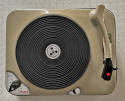 (hint: click thumbnail for full size image)
(hint: click thumbnail for full size image)
-- Thorens TD184
 (these two from Ferruccio's collection)
(these two from Ferruccio's collection)
-- 1961 - Introduction of the Thorens BTD-12s tonearm, intitially for use on the TD124 and the TD135.
-- 1961 - The TD135, (promoted as the inexpensive studio machine for amateurs), equipped with the BTD-12S tonearm -- is introduced. It featured semi-auto operation in that it could turn itself off at end of play, like the TD134. It was positioned upward within the Thorens price line-up directly below the 'top of the line' TD124.
-- Thorens TD135
 Elpa ad: TD135 with BTD-12S
Elpa ad: TD135 with BTD-12S
-- (click thumbnail for full size image)
-- These models, the TD134, TD184 and TD135, were less expensive offerings designed to fill out price points within the product line. The BTD-12S tonearm was well received at its introduction and was the company's top tonearm offering until it was superseded by the TP14 in 1966.
-- The Telefunken Studio 220 was produced this year.
(hint: click thumbnail for full size image)
Link to Studio 220 page in the Thorens Gallery
-- Thanks to Wolfgang Heisse (Ger) for sending in this series of photos of his Studio 220, along with two pdf manuals One for new owner operations and also a service manual. German language. Translation to English is coming. According to Joachim Bung's book (Swiss Precision 2nd ed.) this model sold for 667 German Marks that year. ($380 usd) Not many were sold.
Notes on the Studio 220
circa 1961 and concurrent with the introduction of the TD135 and the BTD-12s tonearm. This model's uniqueness is with its features as well as its cosmetic trim appointments.
--Manufactured by Thorens to custom order for their customer, Telefunken.
--It combines the chassis, drive system, platter, platter bearing and tonearm of the TD135 with the semi-auto features of the TD184 which included auto-start as well as auto-stop or switch to manual. The TD135, by comparison provided auto-stop or manual.
--As with the TD184 there is a setting for the three different record sizes at the start function.
--Cosmetic trim differences include a Telefunken name plate on top of the BTD-12s tonearm pivot bearing case.
--There is another Telefunken nameplate at the speed switch lever
--The Speed, on/off and pitch knobs are unique to the model
--It has a two-tone paint job at chassis exterior.
--Thorens did not produce this exact design under its own name.
_________________________________________________________horizontal rule
--1962 - Introduced this year, the TD 224 Hi Fi record changer
*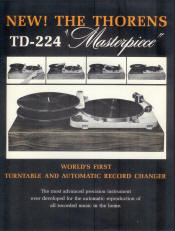
 (hint: click thumbnail for full size image)
(hint: click thumbnail for full size image)
-- Above: Gadget-Guy's TD 224 Masterpiece link to his page within the Thorens Gallery
-- Based on the TD135. but with it's own unique cast chassis plus additional gears, pulleys and levers, arms etc. This 'record changer' stored it's stack of 8 records away from the player so that only one LP rested on the platter at any one time. An arm would pluck the record off the platter, then transport it to the side position, pick a new record from the top stack and place this record on the platter. This is quite unlike the traditional record changer that stacks one LP disc upon the next until you have a stack of 5 or six and spins the whole lot. As that stack of records on the platter rises, so changes the vertical tracking angle and correct arm cartridge alignment is lost. This complexity of changer operation, while extreme, ensured that the all important vertical tracking angle on this Thorens remained unchanged in play. **Video Link**
______________________________________________________________horizontal rule
*1962-- The introduction of the TD121 for buyers in the United States. It was marketed as 'slightly' less expensive than the TD124 but still of high quality.
* Elpa ad for the TD121 and TD111.
Elpa ad for the TD121 and TD111.
(click for full size)
* Left.
Robert Chamber's Thorens model TD121. Equipped as it might have been
purchased new from a Thorens dealer in North America.
Left.
Robert Chamber's Thorens model TD121. Equipped as it might have been
purchased new from a Thorens dealer in North America.
-- Promoted as a Single speed turntable with operation at
33-1/3rd rpm and with variable speed adjustment of ±3%. However, and as
with the TD111, speeds of 16, 33-1/3rd, 45 and 78 rpm were possible by
repositioning the idler wheel against the stepped pulley underneath the
platter. ---And you had to remove the platter to do this.
-- it uses
the lighter bearing of the TD 135 (10mm).
-- It has the one piece
non-magnetic platter of the TD135 (cast zinc)
-- Speed pitch
adjustable to within ± 3% and strobe patterns are found in the center of
the platter mat about the spindle pin. to refine your speed setting.
-- No spirit level,
-- No clutch decoupling.
-- Otherwise it
shares the same chassis casting and drive transmission of the TD124
* TD121 with Shure Dynetic M216 tonearm
TD121 with Shure Dynetic M216 tonearm
-- Above photo from Joachim Bung. Author of the
excellent illustrated Thorens history book (Swiss Precision) from this
period.
See this link for
Joachim Bungs page in the Thorens Gallery)
___________________________________________________________________________horizontal rule
Above: Thorens ELPA ad found in Hifi / Stereo Review presents the TD124, TD135 and TD111 along with accessories the buyer will need to complete the setup.
--1962
-- Above three photos of a TD-111 were sent in to this site by Pat
Omalley back in 2004. These photos represent the 'as found' condition
when Pat first purchased it. For more photos of this unit and info about
the restoration see this link.
-- The
TD111 includes the "essence" of the drive transmission used on the TD124
but with 10mm brg and a 12
inch diameter 8lb one piece non-magnetic platter. It was sold as a
single speed model and the control knob indicated as much by not
including any speed value but while including a ± 3% speed pitch adjust
as was seen on the TD121. A strobe pattern was imprinted on the platter
mat center for 60hz operation at any of the four speeds. Further, it was
possible to switch running speeds between 16, 33, 45 and 78 by manually
re-positioning the idler wheel against the stepped pulley. (After
lifting off the platter, of course.) Not a convenient speed change, but
still possible. After restoring his with a refinish to the original
plinth and mounting a more recent tonearm Pat described his as having
"good bottom end with tons of weighty midrange". I'm thinking this one
should rock and roll just fine.
-- Price for the TD111 was set at $60usd. Add
another $10 for a cabinet-finished in either Walnut, Ebony or Mahogany.
A mounting board for the tonearm of your choice was available at $4.50.
Bring your own tonearm. This was 1962.
-- In Joachim Bung's Book,
Swiss Precision (2nd ed) he tells us that the models TD121, TD111 and
TDK101 were only available in the United States for a short time. And
that Thorens did not make them available anywhere else.
-- Note:
presently I have no photos of a TDK101. However you can find an
advertisement that promotes one in the above noted book by J.Bung. (Page
51)
-- The info I can find tells us that the TDK101 was made
available as a single speed turntable kit (33-1/3rd rpm). Promoted as "A
single speed turntable kit for the do-it-yourself hobbyist". Among its
list of promoted features were: 10 inch non-magnetic platter, (doesn't
specify weight), Variable speed control ± 3%, Belt-idler drive system,
operates on 117 vac @ 60 hz. (for North American use)
-- Price for
the TDK-101 was set at $47.50usd, add plinth in Walnut, Ebony or
Mahogany for $10.00 and the mouting board for $4.50 as was offered with
the TD111 in the same ad.
________________________________________________horizontal rule
-- 1963 The Thorens company merges with
Paillard SA, Sainte-Croix / Switzerland. Paillard SA manufactured Bolex
cameras and Hermes typewriters at the time. This merger would last three
years. Legal requirements and differing goals between upper management
of the Paillard Group and Thorens resulted in a loss of cooperation
between the two groups.
The Thorens TD150
 (click for full size)
(click for full size)
-- 1965 Introduction of the TD150 with TP13 tonearm. This player featured a new 3 point suspended subchassis that
carries both platter, bearing and arm. Fixed to the main chassis is a 16
pole, 2-phase synchronous AC motor. A two- piece 7 pound balanced
platter system exists with the inner platter being driven by means of an
elastic belt. Platter material is die cast zinc alloy. Platter bearing
is a hardened stainless steel shaft of 10mm diameter with a captive ball
bearing in its tip while turning in sintered bronze bushings. The ball
tip carries the vertical load from the platter. This new suspended
layout presents a significant step forward in efforts to reduce rumble
noise.
-- 1966 Effective July 1st, 1966, the Swiss Thorens-Franz AG
took over the entire business concerning Thorens record players and
together with EMT Wilhelm Franz of Germany, they established a new
business for research, development and manufacturing in Lahr / Germany.
Revision of the TD124 into TD124 II with TP-14 tonearm. Changes from
the TD124 include change in paint color from cream white to medium-grey.
Minor changes in the controls. Also revised was the TD135, now TD135 II.
Note; even though the main turntable operations had moved into Lahr,
Germany the TD124/II models continued to be assembled in Sainte-Croix
from parts inventory on hand. (source: Swiss Precision 2nd ed. Joachim
Bung)
________________________________________________________________________horizontal rule
-- Designations: TD125 AB = with Arm and Base, TD125 B = with base, no arm.
--Above sales brochures courtesy of Loron Knowlen
-- 1968 Introduction of the TD125 electronically-controlled
(Wien Bridge Oscillator) turntable equipped with the TP25 tonearm. This
table replaces the TD124 II as the flagship of the product line. The
TD125, like the TD150, is belt driven and suspended via a 3 point
suspension. Like the TD150, it also is a "purists"
model with all manual controls.
Early production units also share
the same platters and bearing shaft with the TD150. Early TD125 models
will be found with the captive ball on the spindle shaft tip. Later
production models replaced this with a solid steel conical shaped tip to
carry the vertical thrust load. The bearing housing on the early models
differed from later production models. Early TD125 model platter
bearings were housed in a large cast aluminum housing featuring a 3 bolt
hole pattern for attachment to the subchassis plate. Later production
bearings were of the press-in variety with a much slimmer machined steel
housing.
Unlike the TD150, this model features a much more
substantial and solid construction throughout. The motor function
offered 3 speeds: 16, 33-1/3 and 45. This table was also offered in an
optional "LB" edition. The "TD125 LB" featured a longer cabinet and
armboard to accommodate longer 12 inch tonearms.
* TD150 mkII with TP13A tonearm.
TD150 mkII with TP13A tonearm.
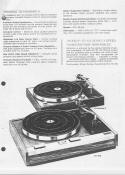
*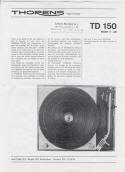
 (click thumbnail for full size image)
(click thumbnail for full size image)
-- Above 5 TD150 mkII brochures courtesy of Munkie NL
-- 1969 Introduction of the TD150 Mk II with new tonearm TP13A. Upgrades to
the tonearm include fine-adjustment of tracking force and 'weight on
string' compensation of anti-skating force. The previous TP13 tonearm
had no compensation for anti-skating force. On the mkII a cue knob, up
front, operates a cable lift system that has been seen on several models
going forward.
* (click) Silvio Anfossi's
TD125-II, SME 3012 S2 in SME custom cabinet. From the period.
(click) Silvio Anfossi's
TD125-II, SME 3012 S2 in SME custom cabinet. From the period.
* magazine ad for the TD125 AB mkII
magazine ad for the TD125 AB mkII
-- 1972 The introduction
of the TD125 MkII. The most apparent change to this revised model is the
new TP16 tonearm which is now packaged as the standard equipment
offering. The new tonearm features gimbal 4-point pivot bearings,
magnetic anti-skate control and a new detachable magnesium headshell,
the TP60. Effective mass of the new arm is rated at 16.5 grams.
Refinements to the oscillator motor control circuitry are made. Platter
bearings are all of the press-in design with solid tip shafts by this
time.
*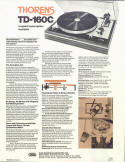 Magazine ads from the period
Magazine ads from the period
 (click for full size)
(click for full size)
The TD160 replaces the
TD150 mkII as the affordable but still
Hi-Fi player featuring a similar 3 point suspension floating sub-chassis
but with the new TP16 tonearm . Operation is pure manual but with an
integrated cable operated tonearm cue. Like the TD150, the TD160 used a
synchronous 16 pole 2-phase AC motor that derived it's pitch precision
by locking on to the mains frequency the same as an electric clock motor
from that era. Both TD125 MkII and TD160 share the same 7 pound die cast
zinc platters and the same 10mm platter bearing.
At the same
time a less expensive TD165 was offered with the TP11 tonearm. This new tonearm used the same gimbal pivot bearing, arm tube and head shell as
the TP16 but substituted a weight-on-string style of anti-skate control
and also featured a different counterweight. The TD165 used a 7mm
diameter platter bearing fixed to a resin inner platter. The motor and
pulley were also different from the TD160.
--
1974 Presentation of
the TD126 "electronic" with tonearm TP16. The TD126 replaces the highly
regarded TD125 Mk II. Similar in dimensions and weight, the TD126 adds
semi-automatic function to the tonearm operation in addition to a preset
for mode of operation. (When equipped with standard Thorens tonearm) The
TD126 featured lighted push buttons compared to the slider controls of
it's predecessor. The TD126 shared the same basic layout and size of the
TD125, continuing to use the heavy cast aluminum sub-chassis suspended
by 3 conical springs and the same platters and bearing. Available speeds
are now 33-1/3, 45 and 78rpm. The Mk 1 and Mk2 TD126 models continued to
use the 16-pole AC synchronous motor from the TD125 MkII.
Editor's Note: So far I've been unable to find any advertising documents for the first version TD126 dating from 1974 or 1975. No magazine reviews either.
Above 5 thumbnails: A TD 126 Electronic product brochure, translated from German to English, courtesy of Aleksandar Kujucev. The brochure was produced by Bolex GMBH Photo HiFi Audiovision circa March 1976, (click thumbnail for full image)
Below: a magazine Ad in High Fidelity Magazine (1976) includes the TD145, TD160C, TD165C and TD126C among the then current lineup of turntables:
*A TD126 magazine Ad by Metrosound in the UK (1976)
 (click for full image)
(click for full image)
*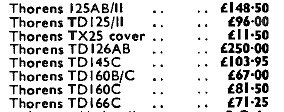 (AT Labs UK price list September 1976)
(AT Labs UK price list September 1976)
--Above photo courtesy of Aleksander
Kujucev: A Thorens TD126B, first version. note that the 'B'
version came minus tonearm and minus any semi auto function -- it's a
purists version where the purchaser would need to provide for the
tonearm of choice and also custom cut an armboard to mount it. Note also
the single push button in front of the armboard. The TD126C
features three lighted pushbuttons in front of the armboard. For more
photos of this turntable in the Thorens Gallery link here
(link)
-- 1975
The TD145 is offered. In essence a TD160 with automated arm lift and
motor stop at end of play (editor's note: apart from different
notation around the on/off speed change knob, the TD145 appears very
nearly identical to the TD160, until you remove the bottom cover and
take a look within.)
*Thorens TD145 magazine ad
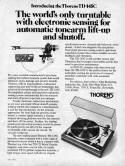 (hint: click for full image)
(hint: click for full image)
-- 1976 Introduction of the "Isotrack"-tonearm
with a low effective mass. This is an updated version of the TP16
tonearm featuring remove-able 'arm wands' fixed by a collar lock very
close to the pivot bearing. Moving the coupling joint closer to the
pivot reduced effective mass substantially. The replaceable arm-wand of
this tonearm is called the TP62. A later version of the isotrack tonearm,
called the TP16-III used another style of arm-wand designated the TP63.
Both of these tonearms rated their effective mass at 7.5 grams. These
tonearms were suitable for use with phono cartridges having high
compliance suspensions.
*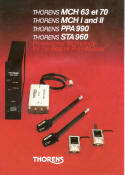
 (click thumbnail for full size image)
(click thumbnail for full size image)
Optional with the Isotrack tonearms were
arm-wands featuring integrated phono cartridges. The TPO63 and TPO70
were two such arm-wands. In cooperation with EMT, Thorens produced
special cartridges of the moving-coil variety. Integrated
arm-wand-cartridges TMC63/TMC70, phono cartridges MCHI and MCHII as well
as the PPA990 and STA960 (pre-preamplifier and step-up transformer)
*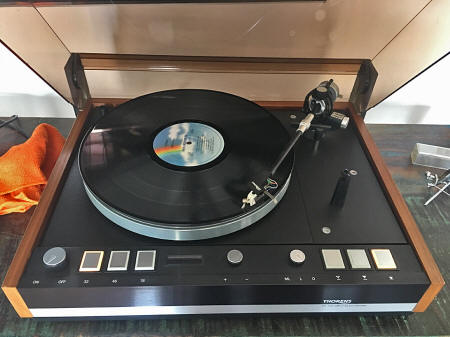 Left and above: Eric Landry's TD126 mkII
Left and above: Eric Landry's TD126 mkII
*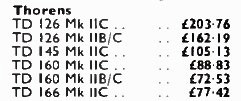
* Introduction of the TD126 Mk II with TP16 Mk II (Isotrack).
*
Introduction of the TD160 Mk II with TP16 Mk II (Isotrack)
*
Introduction of the TD166 with TP16 Mk II (Isotrack)
* Introduction
of the TD145 Mk II with TP16 Mk II (Isotrack)
* Thorens commences
with building the AT410 stereo receiver.
--
1978 Thorens production adds into its
product line the TD104, TD105, TD110, TD115.
--1978 The TD126 MkIII is
introduced. Some of its features include:
* DC 72-pole tacho-generator
drive motor.
* New load-depending control of rotation (APC:
automatic pitch control)
* Low mass "Isotrack" TP16 MkIII
tonearm
* Electronic frictionless shut-off facility
* Additional motor for tonearm lift control
* speeds: 33, 45 and
78
*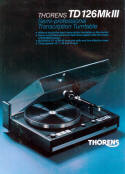
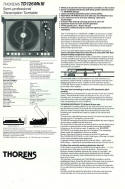 (click thumbnail for full image)
(click thumbnail for full image)
-- Above TD126-III brochure courtesy of Ewan Campbell
The Receiver AT403, Cassette Deck PC 650, Sound Wall
loudspeakers were introduced.
horizontal rule
--The Thorens
"Rumpelmeßkoppler", a device for the measure of the rumble noises of
record players.
*
Above left, design sketch. Above right,
actual tool.
Developed by Thorens engineer Ludwig Klapproth, the
Rumpelmesskoppler (rumble measuring coupler) consists of two parts. One
part is the spindle that is fixed with its lower end to the top of the
turntable axle protruding from the platter. The other end of the spindle
is shaped to a very fine point which is plated with copper and nickel.
The other part of this device is sort of an outrigger which is hung up
at the top of the spindle and supported along the spindle's shaft. The
supports are made of high-polymer plastic and they glide virtually
frictionless around the polished spindle. Fixed at the opposite lower
side of this carrier is a tiny piece of vinyl record with grooves, onto
which the cartrige and its stylus is put during the measurements. This
rather stiff arrangement allows all rumble noises from 0 to around 500
Hz caused by the turntable or it's bearing to be detected and transduced
by cartridge employed.
______________________________________________________horizontal rule
*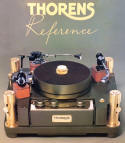 (click for full size)
(click for full size)
-- 1979
Development of the state-of-the-art turntable "Reference" for measuring
purposes. In spite of the stated purpose as a measurement tool, a series
of 100 Thorens References were sold to customers. Unofficially, more
were made but it is unknown exactly how many and what serial numbers
those extra turntables carried.
-- 1979 continued:--Introduction of the TP16 MkIII
tonearm
-- 1979-1981 The TD126 Mk III, is
now being offered with
numerous different tonearms from the various popular tonearm manufacturers
including SME, Koshin, Dynavector and EMT. Semi-auto function is
retained when these arms are factory installed.
*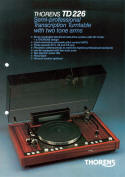
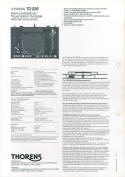
--
1981-1983
Introduction of the TD226, featuring a vacuum pump platter mat and space
for two tone arms. The introduction of the TD127, essentially a TD126
with extended cabinet and arm board to accommodate a 12 inch tonearm.
One example of a TD127 known to us came equipped with the earlier
16-pole synchronous motor, 10mm platter bearing and cast zinc inner
platter.
*
 (click thumbnail for full size image)
(click thumbnail for full size image)
-- 1982 Introduction of the upgraded TD166 Mk II
Introduction of the TD147
-- Introduction of the TD 160 Super
-- The TD160 Super was in essence a standard TD160 mkII but with the
following features:
bullet a larger more solid cabinet
bullet
damping material applied to the underside of the motor plate and
sub-chassis pan
bullet heavier bottom plate
bullet typically
delivered with base but no tone arm. But sometimes supplied with TP16
MkIII (Isotrack)
bullet Dustcover has more substantial steel hinges
*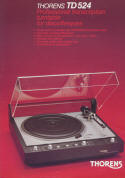
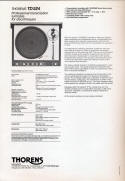 TD524 brochure courtesy of Rolf Kelch Electronics
TD524 brochure courtesy of Rolf Kelch Electronics
Presentation of the TD524, marketed
as a turntable for discotheques featuring:
*Direct drive
*DC motor with a 256 pole tachogenerator
*quartz motor
speed control
*pitch control +- 6%
*speeds: 33,45 and
78
*speed accuracy rated at zero error
*platter:
aluminum alloy with a high damping rubber mat
*Rumble figure:
-52db DIN45539
*Rumble figure: according to Rumplemesskoppler
unweighted: -62db
*Tonearm: TP16L (long) (Spezial)
*effective length: 245mm
*offset angle: 22 degrees
*skating compensation: magnetic
*Remote control for: arm lift,
start/stop, commutation between quartz lock and pitch control, start
from mixing console
*accessories: mounting frame, dust cover
with spring hinges
*Dimensions: 500 x 445 x 180mm (over closed
cover)
-- 1983 The Thorens Prestige is introduced.
*
 (click thumbnail for full size image)
(click thumbnail for full size image)
Having much in common with the Thorens Reference, the Prestige was a no
compromise, no nonsense turntable. The Prestige had the following
features:
-- Belt drive
-- servo controlled 2-phase
synchronous motor
-- speeds: 33-1/3, 45, 78
-- motor speed
control: quartz controlled electronic 2 phase generator
-- pitch
control: +- 6%
-- platter: 8.1 kg complete with mat and gold
weight
-- platter dia. : 34 cm
-- large 14mm platter
bearing with iron granule damping
-- Wow and flutter: Din 45507,
< 0.02%
-- Rumble unweighted: Din45539 > 54dB
-- Rumble
weighted: Din45539 > 70 dB
-- Rumble mesured with Thorens
Rumpelmesskoppler, Din unweighted: > 70 dB
-- weighted: > 80 dB
-- dimensions 612 x 510 x 280
-- weight: 55 kg
___________________________________________________________________horizontal
rule
-- The company's structure is reorganized and
divided into three independent companies:
-- Thorens-Cabasse
Vertriebs GmbH, (sales distribution in Germany)
-- Thorens
Produktions GmbH and ,(R&D and manufacturing in Lahr)
-- EMT-Franz
GmbH (R&D of professional studio equipment)
Introduction of the
TD146, an semi-auto variant to the TD166
Introduction of the
TD147 Jubilee (a centennial anniversary edition)
-- TD147 Jubilee
 (hint: click this thumbnail for full sized image)
(hint: click this thumbnail for full sized image)
-- TD126 MkIII
Centennial edition:
*a series of 100 tables with special trim
(black and gold anodized metal parts)
*could be ordered with SME 3010-R tonearm while retaining auto-lift functions
*could
be ordered in different wood trims (Rosewood for example)
*standard tonearm: TP16 MkIII
1984 Design, development and
introduction of the new standard: TD320
-- This deck differs from
previous Thorens models in the following ways:
*Medium Density
Fiberboard (MDF) is the construction material
*3 point
suspended subchassis as with others but subchassis is now open
*conical springs are replaced with leafs
*16 pole AC synchronous
motor is controlled by a 2-phase generator.
*

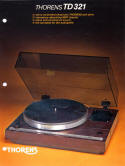
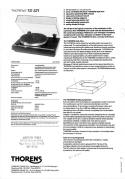
Many variants were
produced based upon this layout including the following:
*TD316
*TD318
*TD321
*TD320
*Phantasie
*TD520
*TD521
Thorens would spring their suspended
chassis' with leaf springs from this point forward. For more information
on the TD320 link here.
-- 1985 Introduction of the TD520
professional, successor to the TD126. The 520 uses the same layout as
the TD320 but is larger, heavier and supports the use of 12 inch tonearms.
*

--1988
-- Presentation of the new tonearm design
TP90.
-- Presentation of the Thorens "Concrete".
*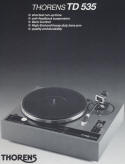 The TD535 for Broadcast and Disco
The TD535 for Broadcast and Disco
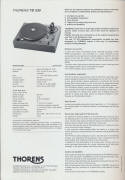
Editor's note re: TD535. I've never
seen one or looked at photos of one except for the above brochure
supplied by Rolf Kelch Electronics. If anyone has one of these and
would like to share photos of it I'd be happy to publish those here on
this site and within the Thorens Gallery.
-- 1989
Development and production of the TD2001
* (click thumbnail for full size image)
(click thumbnail for full size image)
1990 TD3001, an improved
variant of the TD2001
-- Same plinth as TD2001
-- much
improved (quieter) 24 pole, 2-phase motor
-- Platter and subplatter are turned from solid aluminum stock, then precision balanced
-- detachable tonearm board
-- The TP90 is upgraded to TP90S
to be used as standard on the TD3001
*
1990-1991 Thorens-Franz
AG in Wettington, Switzerland, files for Bankruptcy...according to
Joachim Bung in his book "Swiss Precision" 2nd ed. pge. 94
Thorens Audio HiFi Vertriebs GmbH sales/distribution move to new
premises at Lahr and Berlin. New owner Herr Helmut Leitner (source:
article, Pasini; "Thorens TD Series Turntable Classics"
1991
Presentation of the new tonearm TP50 and the TD180 semi-automatic record
player.
1992 Introduction of the TD290 "Budget High-End"
turntable.
1993 The production of the low-priced Thorens record
players starts up in Lodz / Poland. ( Unitra Works?)
1994
Development and introduction of new Thorens proprietary electronic audio
components. Considered absolutely High-End and provided with the family
name "Thorens Consequence", the first devices to hit the market are a
highly musical preamplifier and power amplifier. Presentation of the
Thorens "Classic" line, a pre and power amplifier employing tubes.
1995 Foundation of the Thorens Laboratory in Berlin with the purpose
of developing and manufacturing High End audio components. Introduction
of the CD player, D/A converter and RDS-tuner.
1996 The "Thorens
Consequence" family welcomes a pair of powerful mono block amplifiers
and a unique power line conditioner.
1999 Thorens TD325 is shown
at CES '99.
Dec/2000 Thorens was refused to claim Chapter 11
bankruptcy by the German government. Thorens is then looking to move
their operations back to Switzerland and are searching for new
investors. (source: Enjoy the Music)
May/2002 Restructuring of
ownership and shareholder organization. New management appointed to
re-launch the brand "Thorens". Thorens Export Corporation Ltd.
Kaiseraugst / Switzerland, has been appointed to manage the OEM -
production sector. (source: Enjoy The Music)
2004 Heinz Rohrer,
by now, has 75% ownership in Thorens Export Corp. Ltd and launches a new
line of completely different turntables under the old brand name
May 01 2018 New owner - Thorens returns to Germany
"Gunter Kuerten takes Thorens. The former CEO of ELAC and Denon (with
additional leadership experience at LG, Loewe, Sharp and Sony), founded
the new Thorens GmbH in Bergisch Gladbach. By this beginning with May
1st, another worldwide leading brand in analog HiFi is located there and
makes the region to Germany's Analog Valley.
Thorens is the
oldest name in entertainment electronics, founded in 1883 by Hermann
Thorens in Sainte-Croix, Switzerland. The brand is still worldwide known
for its high-quality record players. During the sixties of the 20th
century the company moved to Lahr in Germany. Later when Heinz Rohrer
became CEO, Thorens returned temporarily to Switzerland. Gunter Kuerten
is a very experienced and successful industry insider. Because of this
Thorens will be in good hands and ready for future challenges.“, so
Heinz Rohrer.
I am committed to the tradition of Thorens and I see my
job in keeping the brands legacy but also in further developing this
‘analog jewel’ “, confirms Gunter Kuerten. “I see a lot of future
chances in the opening of markets. And the worldwide vinyl revival is
going to assist us in that.
Thorens GmbH
Lustheide 85
51427
Bergisch Gladbach
Germany
info@thorens.com
ph: +49 (0)
2204-8677720"
Editor's note: Above news is quoted from the
Thorens website
link: https://www.thorens.com/en/thorens-news/thorens-news.html
bullet The major source for this information is from a Thorens
company pamphlet detailing the brand's production history. Title:"
Thorens; The fascination of a living legend" Published by Thorens Audio
HiFi-Vertriebs GmbH, compiled by Gerhard Weichler in Lahr, Ger. ( I got
my copy courtesy of Rolf Kelch Electronics)
bullet Joachim Bung's
book "Swiss Precision" 2nd ed. English language version -- (Please note
that I bought my copy from Joachim Bung)
bullet article by Dr.
Stefano Pasini titled "The Legacy of Thorens TD Series Turntable
Classics" This article was first published in Sound Practices magazine
and is now available from Stefano's website
bullet Rudolf Bruil's
most useful website on the TD124 and TD224 at http://www.soundfountain.com/amb/td124page.html,
back to the Thorens Dept.
Note: This website is not affiliated with or sponsored by Thorens









